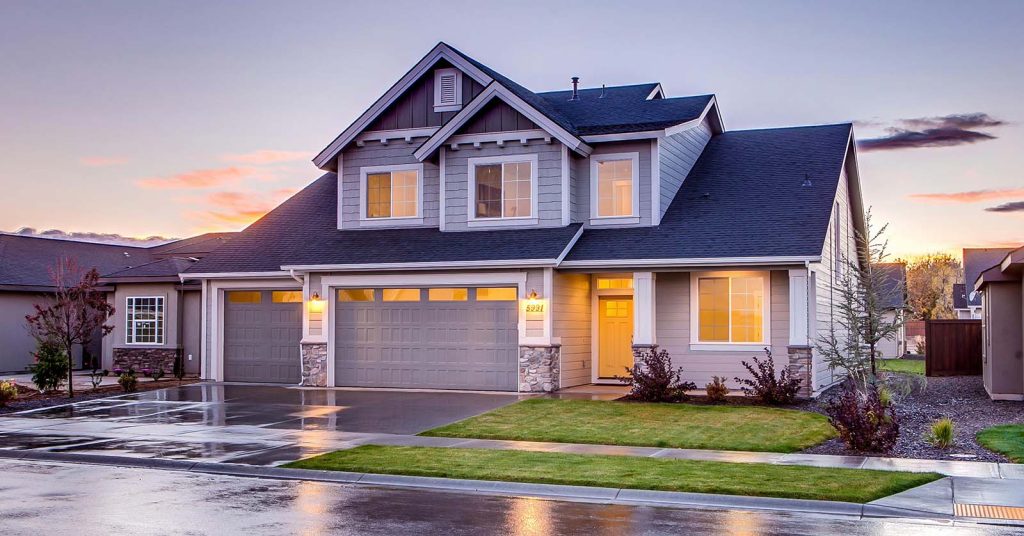Home equity is the portion of your home’s value that you truly own. In simple terms, it’s the difference between your property’s current market value and the outstanding balance of any mortgages or liens on the home. For example, if your house is worth $300,000 and you owe $200,000 on your mortgage, you have $100,000 in home equity. This equity grows over time as you pay down your loan and as the property value potentially increases.
Quick Formulas
Home Equity = Current Home Value – Total Mortgage & Liens
Equity % = (Home Equity ÷ Current Home Value) × 100
Loan-to-Value (LTV) = (Total Mortgage & Liens ÷ Current Home Value) × 100
Note: Equity % + LTV = 100%
Key Takeaways
- Home equity represents ownership in your home: It’s calculated as your home’s market value minus the balances of your mortgage and any other home loans. If you own your home free-and-clear, you have 100% equity.
- Equity builds as you pay down debt or home values rise: Making mortgage payments (especially toward principal) increases your equity stake, and price appreciation can boost equity even if your loan balance stays the same.
- It’s an asset, but not a liquid one: Home equity counts as part of your net worth and wealth, but you typically must sell the home or borrow against it to access that money. This “wealth on paper” can fluctuate with the housing market.
- Record-high equity in the U.S.: U.S. homeowners reached roughly $17.8 trillion in total home equity by Q3 2025, a record high, with an average of $213,000 in tappable equity per homeowner (after leaving a 20% cushion). Home equity is a major source of wealth for many families.
Understanding Home Equity
Definition: Home equity is the value of your financial interest in your home. It starts with your down payment and increases as you pay off your mortgage and as the home’s value goes up. More formally, it’s your property’s current market value minus any liens (such as mortgages) against it. If you purchased a home with a loan, the lender has an interest in the property until the debt is repaid. Your initial equity is the portion you paid for (for instance, a 20% down payment gives you 20% equity at the start). With each mortgage payment, especially the portion going to principal, your ownership stake (equity) grows while the lender’s stake shrinks.
Example: Imagine you bought a house for $250,000 with a 10% down payment ($25,000). Your initial equity is $25,000 (10% of the value). The remaining $225,000 was financed by a mortgage, so initially the bank “owns” 90% of the home’s value. Over time, as you pay down the mortgage balance to say $200,000 and the home’s market value rises to $280,000, your equity would increase significantly. At that point, your equity = $280,000 (value) – $200,000 (loan) = $80,000. This equity represents the wealth locked in your home that you could potentially tap into.
It’s important to note that home equity isn’t fixed – it changes over time. If you make extra principal payments or home values surge, your equity builds faster. Conversely, if property values decline or you take on additional loans (like a home equity loan or second mortgage), your equity can shrink. In fact, if your mortgage balance exceeds your home’s value, you’d have negative equity (also called being “underwater” on your mortgage). For instance, owing $210,000 on a home now worth $200,000 means you have –$10,000 in equity, a situation to avoid because it means you owe more than the home is worth.
How Value Changes Impact Equity
| Scenario | Home Value | Total Liens | Equity | Equity % |
|---|---|---|---|---|
| Baseline | $300,000 | $200,000 | $100,000 | 33.3% |
| +5% Appreciation | $315,000 | $200,000 | $115,000 | 36.5% |
| –5% Decline | $285,000 | $200,000 | $85,000 | 29.8% |
Why Home Equity Matters
Home equity can be a powerful financial resource and is often a cornerstone of personal wealth. For many American homeowners, equity makes up a large portion of their net worth. Paying down a mortgage is sometimes called a “forced savings account” – as you pay principal and your home potentially appreciates, you are essentially saving money in the form of growing equity. According to recent data, homeowners collectively have trillions of dollars in equity, reaching new highs in 2025. This means homeownership has helped many families build wealth over time, especially during periods of rising real estate values.
However, it’s critical to remember that home equity is not a liquid asset. Unlike cash in a bank or stocks you can sell easily, the money “stored” in your home’s equity isn’t readily accessible for day-to-day needs. To unlock it, you generally have to either sell the house or borrow against the equity. This leads to costs or obligations (transaction fees, new loan payments, etc.). So while equity contributes to your financial stability and net worth, you should view it as a long-term asset.
Home equity also matters because it protects you in market downturns. Having a healthy equity cushion (for example, owing far less than the home’s value) can prevent you from going underwater if property prices drop. Lenders often require at least 20% equity to refinance or avoid private mortgage insurance, emphasizing how equity is tied to financial resilience. In short, the more equity you have, the more financial flexibility and security you tend to gain.
How Can You Use Home Equity?
Since home equity represents real value, homeowners often leverage it for important financial goals. There are a few common ways to tap your equity (short of selling the home):
- Home Equity Loan (Second Mortgage): This is a loan where you borrow a lump sum and use your home equity as collateral. You repay it in fixed installments over a set term. It effectively converts part of your equity back into debt (cash in your pocket now, but a second mortgage to pay off). Home equity loans are often used for one-time needs like home renovations, college tuition, or consolidating higher-interest debt. Because the loan is secured by your home, interest rates are usually lower than credit cards or personal loans, but defaulting could put your home at risk.
- Home Equity Line of Credit (HELOC): A HELOC works like a credit line backed by your equity. Instead of a lump sum, you get an approved credit limit and can borrow as needed during a draw period. You only pay interest (and later principal) on the amount you actually borrow, not the full line. HELOCs often have variable interest rates. They are useful for ongoing expenses or projects where you aren’t sure exactly how much you’ll need (for example, a series of home improvements over time). As with a credit card, you can borrow, repay, and re-borrow during the line’s term, usually up to the limit. The flexibility is great, but discipline is required to avoid over-borrowing.
- Cash-Out Refinance: This replaces your existing mortgage with a new, larger mortgage, and you take the difference in cash. Essentially, you refinance your remaining loan balance plus add a certain amount of your equity into the new loan, receiving that equity in cash at closing. For example, if you owe $150,000 and have $300,000 in home value, you might refinance into a $200,000 loan – $150k pays off the old loan, and you get $50k (minus costs) out to use. Cash-out refinances can be a way to lock in a new interest rate or change your loan term while also withdrawing equity. They’ve been popular when interest rates drop, though in high-rate environments, homeowners are more reluctant to refinance.
- Reverse Mortgage: Targeted at older homeowners (62+ in the U.S.), a reverse mortgage (often a HECM – Home Equity Conversion Mortgage) lets you draw on your home equity for income without making immediate repayments. Instead, the loan is repaid when you sell the home or pass away. This is a specialized product for retirement funding, and it reduces your equity over time as you receive payments. (For most homeowners under 62, this isn’t an option, but it’s worth noting as a use of equity in later life.)
HELOC vs. Home Equity Loan: Key Differences
| Feature | Home Equity Loan | HELOC |
|---|---|---|
| Type | Lump-sum, fixed-term installment loan | Revolving line of credit with draw period |
| Interest Rate | Usually fixed | Usually variable (can adjust over time) |
| Payments | Fixed monthly principal & interest | Often interest-only during draw; amortizing in repayment period |
| Best For | One-time, known-cost projects (e.g., roof, debt consolidation) | Ongoing or uncertain costs (e.g., phased renovations) |
| Predictability | High — payment amount stays the same | Medium — rate & payment can fluctuate |
Tips for Building Equity Faster
Because home equity can take years to grow, you might want to actively manage and accelerate its buildup. Here are some tips to increase your home equity more quickly:
- Make a larger down payment if possible: The more you put down upfront, the more immediate equity you have. A big down payment (20% or more) not only gives you a head start on equity, it can also help you avoid private mortgage insurance and reduce your monthly payment. However, always ensure you keep enough savings in reserve for emergencies after the purchase.
- Pay down your mortgage principal faster: Consider paying a bit extra on your mortgage each month or making biweekly payments. Reducing the loan principal ahead of schedule directly increases your equity. Even one extra payment per year, or small additional principal payments, can substantially shorten your loan term and boost equity sooner. Before doing this, check that your lender applies extra payments to principal and that there are no prepayment penalties (most standard mortgages don’t have these).
- Choose a shorter loan term or refinance wisely: Loans with shorter terms (like a 15-year mortgage instead of 30-year) build equity faster because you pay off the principal more aggressively with each payment. If you can afford the higher monthly payments, refinancing into a shorter term or at a lower interest rate can accelerate equity growth. Just be mindful of closing costs and ensure the refinance is worth it.
- Increase your property’s value with smart improvements: Home renovations and upgrades can raise your home’s market value, adding to your equity – but choose projects with a good return on investment. Remodeling magazines and studies show that some projects (like replacing an old garage door or minor kitchen remodels) may recoup a high percentage of their cost in home value, whereas very expensive or highly personalized upgrades might not. It’s wise to research which improvements add value in your market. Even basic upkeep and maintenance (fixing a leaky roof, updating an old HVAC, landscaping) preserve and can enhance value, protecting your equity.
- Stay put for a while: Home equity generally grows with time. In the early years of a mortgage, your payments are mostly interest, so principal (equity) builds slowly. Over time, that balance shifts and you gain equity faster with each payment. Additionally, home values historically tend to rise over the long term. If you move or sell too soon, you might not have built much equity yet (and transaction costs could eat into what equity you did gain). Many experts suggest a homeowner should plan to stay at least 5 years to build enough equity to offset buying and selling costs.
Summary
Home equity is one of the key financial benefits of homeownership. It’s essentially your ownership stake in your home and a form of forced savings that grows over time. Understanding home equity helps you make wiser decisions, whether it’s refinancing, taking a home equity loan, or determining if you’re in a good position to sell. A higher equity position gives you more security (less chance of owing more than the home is worth) and more options for leveraging that value. However, tapping into equity should be done cautiously, since your home is at stake. By building and managing your home equity carefully, you can use it to your advantage – funding important goals or bolstering your retirement – while keeping your financial house in order. In short, home equity is a powerful tool for wealth-building when used responsibly.
Frequently Asked Questions (FAQs)
What happens to my home equity when I sell my house?
When you sell, your home equity typically turns into cash (your profit) at closing. The sale proceeds will first go to pay off the remaining mortgage and any other liens. After that, whatever is left belongs to you. For example, if you sell for $400,000 and you owe $250,000 on your mortgage, roughly $250,000 will go to the lender to pay off the loan, and the remaining $150,000 (minus transaction costs like realtor commissions, taxes, etc.) is yours – that was your equity. Home equity essentially becomes your net proceeds from the sale.
Can I lose equity in my home?
Yes. Your equity isn’t guaranteed to always increase – it can decrease if home values fall or if you increase your debt against the home. If the market value of your home drops, your equity goes down accordingly. For instance, a market downturn might reduce your home’s value from $300,000 to $270,000; if your loan was $200,000, your equity went from $100,000 down to $70,000. Taking out new loans that use your home as collateral (such as a second mortgage or HELOC) can also reduce your equity since you’re effectively converting equity back into debt. In extreme cases, one can end up with negative equity (owing more than the home is worth) if values plummet or a lot of debt is accumulated. To protect your equity, it’s wise to maintain a reasonable loan-to-value ratio and avoid borrowing more than you need.
How much equity do I need to have to get rid of PMI?
Private mortgage insurance (PMI) is required by many lenders if your down payment was less than 20%. You can request to cancel PMI once your equity reaches 20% of the home’s value. In fact, federal law (Homeowners Protection Act) mandates that PMI must be automatically canceled when your loan balance drops to 78% of the home’s original value (which corresponds to 22% equity, assuming you’re current on payments). To reach 20% equity faster, you can pay down your mortgage principal or if your home’s value has risen, contact your lender – they may require an appraisal to verify the new value. Reaching that 20% equity threshold is key; at that point, you not only save money by dropping PMI, but you also have a more comfortable cushion of ownership in your home.
Sources
- MyCreditUnion.gov – Home Equity Loans and Lines of Credit (National Credit Union Administration)
- Consumer Financial Protection Bureau – What You Should Know About HELOCs
- Investopedia – Home Equity: What It Is, How It Works
- NerdWallet – Home Equity: What It Is and Why It Matters
- CBS News – Homeowners have equity to borrow now: How to calculate yours
- Bankrate – How to Build Equity in Your Home


